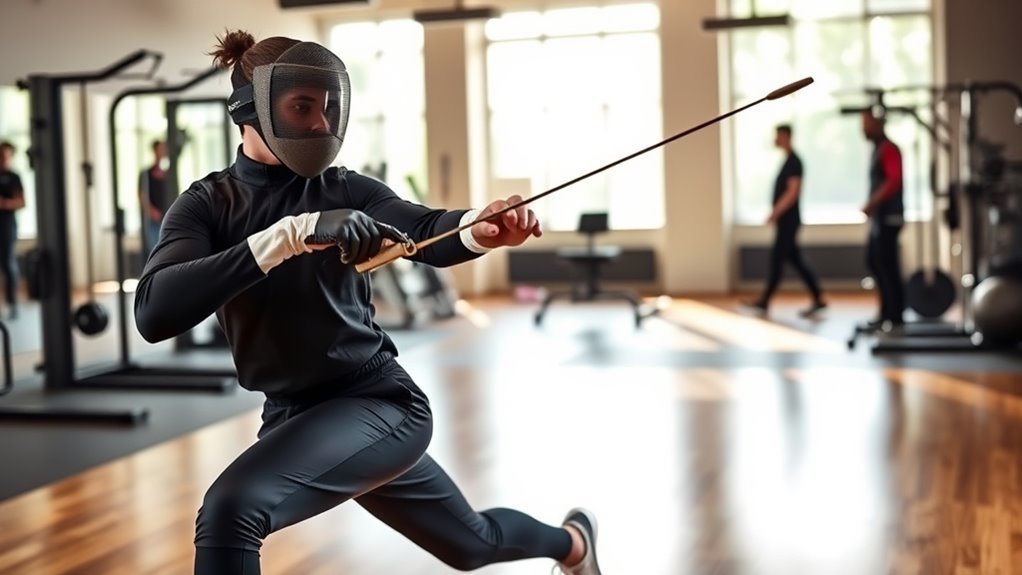To boost your lower-body strength as a sprinter, focus on key exercises like squats, deadlifts, and lunges. These moves help build explosive power, improve balance, and enhance agility. Don't forget calf raises for sprint starts and plyometric exercises for additional explosiveness. You'll also want to strengthen your core for better stability and efficiency. These workouts can greatly improve your speed and power. Keep going to discover effective strategies that will elevate your sprinting performance even more!
Importance of Lower-Body Strength for Sprinters
Lower-body strength is essential for sprinters, as it directly impacts speed and power. When you focus on building strength in your legs, you're not just enhancing your performance; you're revealing your potential. Strong legs provide the explosive power needed to propel you forward, allowing you to leave your competitors in the dust. You'll find that each stride becomes more efficient, letting you cover ground faster and with less fatigue.
Moreover, lower-body strength helps prevent injuries, keeping you free to chase your goals. With a solid foundation, you can push yourself harder, whether you're training or competing. It's all about that feeling of freedom when you sprint, knowing your body is capable and resilient. Embracing lower-body strength means embracing the thrill of speed, enabling you to push limits and savor the joy of running. So, invest time in your legs, and you'll reap the rewards on the track. Additionally, incorporating plyometric exercises into your routine can significantly enhance your explosiveness and overall leg power.
Squats: The Foundation of Lower-Body Strength
Building on the importance of lower-body strength, squats stand out as a cornerstone exercise for sprinters. They help you build explosive power, essential for those short bursts of speed. When you squat, you're engaging multiple muscle groups, including your quads, hamstrings, and glutes, which translate directly to increased sprinting capability.
You don't need fancy equipment; just find a comfortable space and focus on your form. Start with bodyweight squats, and as you gain confidence, you can add weights to challenge yourself further.
Incorporating squats into your routine will enhance your overall strength, stability, and performance on the track. Plus, they promote better mobility, allowing you to move freely and efficiently. Additionally, enhancing performance in various sports can also benefit your sprinting by improving overall athleticism.
Deadlifts: Building Power and Stability
While squats are essential, deadlifts also play an important role in enhancing your power and stability as a sprinter. This exercise targets your posterior chain, which includes your glutes, hamstrings, and lower back, all fundamental for explosive speed. By incorporating deadlifts into your routine, you're not just building strength; you're also improving your overall athletic performance.
When you execute deadlifts, focus on maintaining proper form. Keep your back straight and engage your core to prevent injury. Start with lighter weights to master the technique, then gradually increase as you gain confidence. The beauty of deadlifts lies in their versatility—whether you prefer traditional, sumo, or trap bar variations, you can find a style that resonates with you.
Ultimately, deadlifts empower you, giving you the strength and stability needed to push your limits on the track and achieve the freedom of speed. Additionally, developing core strength through deadlifts supports the spine during exertion, reducing injury risk and enhancing overall performance.
Lunges: Enhancing Balance and Agility
Lunges are a fantastic way to boost your balance and agility, essential for sprinters. You'll want to explore different types of lunges and focus on proper form to maximize their benefits. Let's break down the key techniques and variations you can incorporate into your training. Additionally, incorporating core strengthening exercises can further enhance your overall performance and stability during sprints.
Types of Lunges
When it comes to enhancing balance and agility, incorporating different types of lunges into your training routine can make a significant difference. You've got options! Start with forward lunges, which engage your quads and glutes while improving stability. Reverse lunges are great for targeting your hamstrings and lower back, allowing for a smoother motion. Side lunges help you develop lateral movement, essential for sprinting. Don't forget walking lunges, which challenge your balance and mimic the dynamic nature of running. Finally, consider jump lunges for an explosive boost to your power and speed. Mixing these variations keeps your workouts fresh and fun, while also building the strength and agility you need to sprint confidently. Enjoy the freedom of movement!
Proper Form Techniques
Mastering proper form during lunges is essential for maximizing their benefits and preventing injury. When you step forward, keep your knee aligned with your ankle, ensuring it doesn't extend past your toes. Your back should remain straight, and your core engaged to maintain balance. As you lower yourself, aim for a 90-degree angle in both legs, which enhances stability. Don't forget to push through your front heel as you return to the starting position—this strengthens those vital muscles. To boost your agility, try alternating lunges while keeping your movements smooth and controlled. Remember, it's not just about power; it's about crafting a fluid, dynamic motion that'll translate to your sprinting performance. Embrace the freedom of movement!
Plyometric Exercises: Boosting Explosiveness
To enhance your explosiveness on the track, incorporating plyometric exercises into your training regimen can be a game-changer. These dynamic movements help you develop power and speed, essential for sprinting success. Here's a quick look at some effective plyometric exercises:
| Exercise | Reps/Duration | Benefits |
|---|---|---|
| Box Jumps | 3 sets of 8 | Builds leg strength and power |
| Depth Jumps | 3 sets of 6 | Enhances reactive strength |
| Broad Jumps | 3 sets of 5 | Improves horizontal explosiveness |
| Jump Squats | 3 sets of 10 | Boosts overall speed |
Integrating these exercises into your routine not only improves your sprinting performance but also brings a fun, explosive element to your workouts. Remember, consistency is key! Embrace the freedom of movement and watch your explosiveness soar. Additionally, plyometric training enhances coordination and improves neuromuscular control, making you more agile on the track.
Leg Press: Targeting Key Muscle Groups
While many exercises contribute to lower-body strength, the leg press stands out for its ability to effectively target key muscle groups essential for sprinters. This machine allows you to push heavy weights, primarily engaging your quadriceps, hamstrings, and glutes. By focusing on these major muscle groups, you're building the power and speed needed for explosive sprints.
One of the leg press's greatest advantages is its versatility. You can adjust the foot placement to emphasize different muscles, giving you the freedom to tailor your workout to your specific needs. Whether you want to enhance your sprinting speed or improve overall lower-body strength, the leg press is a fantastic choice.
Incorporating the leg press into your routine not only boosts your strength but also increases stability in your lower body, helping you maintain balance during those intense runs. Additionally, combining the leg press with squats and lunges can further enhance your lower-body strength and explosive power. So, don't hesitate to add it to your training arsenal!
Calf Raises: Strengthening the Lower Leg
Building on the strength you gain from the leg press, calf raises play a significant role in developing the lower leg. Strong calves not only enhance your sprinting speed but also improve your overall stability and agility. Here's why you should incorporate calf raises into your routine:
Calf raises are essential for building strong legs, boosting sprinting speed, stability, and agility. Incorporate them into your routine for better performance!
- Increased Power: Strong calves contribute to explosive starts, giving you the edge you need on the track.
- Better Balance: Strengthening your lower legs helps maintain balance during high-speed sprints, reducing the risk of injury.
- Enhanced Endurance: Well-developed calves can improve your stamina, allowing you to sustain speed over longer distances. Additionally, strong calves provide explosive power for quick take-offs and assist in maintaining balance and stability during jumps.
To perform calf raises, you can use a step or a weight plate. Aim for three sets of 12-15 reps, gradually increasing the load as you get stronger. Embrace the freedom that comes with powerful, agile legs, and watch your sprinting performance soar!
Core Strength: Supporting Sprinting Performance
Your core strength plays an essential role in sprinting performance, as it provides the stability needed for powerful strides. By focusing on core exercises, you can enhance your overall speed and agility on the track. Let's explore the importance of core stability and the best exercises to boost your sprinting capabilities. Additionally, strengthening your core helps to reduce injury risk, allowing you to maintain peak performance throughout your training and competitions.
Importance of Core Stability
Core stability plays an essential role in enhancing sprinting performance, as it acts as a foundation for strength and power. When your core is strong and stable, you can run faster and more efficiently, freeing you to focus on your speed and technique. Here are three key benefits of core stability for sprinters:
- Improved Balance: A stable core helps you maintain balance during your sprint, reducing the risk of injury.
- Enhanced Force Transfer: A strong core allows for better force transfer from your legs to the ground, increasing sprinting speed.
- Increased Endurance: Core stability supports proper posture, helping you maintain energy levels throughout your race.
Exercises for Core Strength
A strong core isn't just about aesthetics; it's pivotal for sprinters aiming to enhance their performance on the track. Here are some effective exercises to build that strength:
| Exercise | Sets | Reps |
|---|---|---|
| Plank | 3 | 30s |
| Russian Twists | 3 | 15 |
| Bicycle Crunches | 3 | 20 |
| Dead Bug | 3 | 10 |
| Mountain Climbers | 3 | 15 |
Incorporating these into your routine will stabilize your movements, allowing for more power and efficiency. A robust core supports your entire body, helping you feel free and agile on the track. So, embrace these exercises and watch your sprinting performance soar!
Core's Role in Sprinting
While sprinting might seem like a purely lower-body activity, the truth is that a strong core plays an essential role in optimizing performance. Your core stabilizes your body, allowing for efficient energy transfer and better sprint mechanics. Here's how it supports your sprinting:
- Improved Stability: A strong core helps maintain balance, reducing the risk of injury and enhancing your speed.
- Power Transfer: Your core acts as a bridge, enabling effective power transfer from your legs to your upper body, which boosts your overall speed.
- Injury Prevention: Strengthening your core can help prevent common injuries by supporting your spine and pelvis during intense sprinting.
Frequently Asked Questions
How Often Should Sprinters Perform Lower-Body Strength Workouts?
You should aim for lower-body strength workouts two to three times a week. This frequency helps build power without overtraining, allowing you to maintain your freedom in movement while enhancing your performance on the track.
What Is the Best Warm-Up Routine Before Strength Training?
Before strength training, you should do dynamic stretches and mobility exercises to loosen up. Try leg swings, lunges, and light jogging. This'll prepare your muscles and joints, ensuring you're ready for an effective workout.
Can Lower-Body Strength Workouts Prevent Injuries?
Can lower-body strength workouts really prevent injuries? Absolutely! By strengthening your muscles and improving stability, you're reducing your risk. So, why not embrace these workouts for better performance and freedom in your movements?
How Do I Measure Progress in Lower-Body Strength?
To measure progress in lower-body strength, track your weights, reps, and sets over time. You can also assess your performance in functional movements, like squats and lunges, to see improvements in your strength and endurance.
Should Sprinters Prioritize Strength Training Over Speed Workouts?
You should balance strength training with speed workouts. Prioritizing one over the other can limit your potential. Building strength enhances explosive power, while speed workouts improve your quickness—both are essential for ideal performance and freedom on the track.




